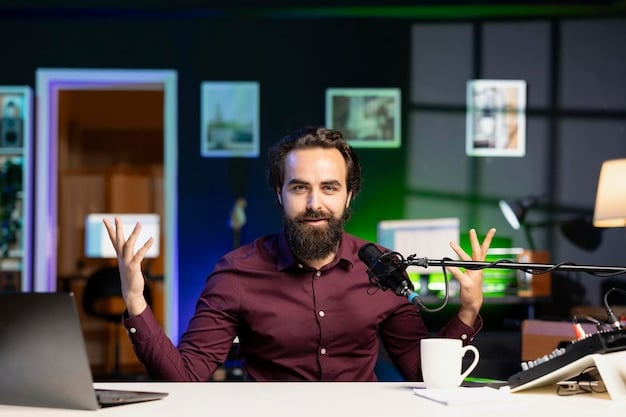Mastering Podcast Sponsorships: Rates & Long-Term Deals in 2025

Navigating the evolving landscape of podcast sponsorships in 2025 requires strategic negotiation of rates and a clear understanding of audience value to secure lasting partnerships that drive sustainable revenue for creators and effective reach for brands.
In the dynamic world of audio content, understanding Podcast Sponsorships: Negotiating Rates and Securing Long-Term Partnerships in 2025 is paramount for both creators seeking sustainable revenue and brands aiming for authentic audience engagement. This guide delves into the strategies, trends, and pitfalls to navigate this lucrative intersection, ensuring your next deal is not just a transaction, but a foundational step towards enduring success.
The Evolving Landscape of Podcast Sponsorships in 2025
The podcast industry continues its meteoric rise, evolving from a niche medium to a mainstream consumption habit for millions. In 2025, this growth brings both unprecedented opportunities and heightened complexities for securing sponsorships. Brands are increasingly recognizing the unique intimacy and engagement podcasts offer, shifting budgets from traditional media to capitalize on this direct connection with highly engaged audiences. However, this increased interest also means more competition for creators and a need for more sophisticated negotiation tactics. Understanding the current market trends, listener demographics, and technological advancements becomes crucial for both podcasters and potential sponsors.
Audience Centricity: The New Gold Standard
Today’s successful sponsorships are deeply rooted in audience understanding. It’s no longer enough to simply state download numbers; sponsors demand detailed insights into listener demographics, psychographics, and behaviors. This shift empowers podcasters who can articulate their audience’s value beyond mere volume, focusing on engagement and purchasing power.
- Demographic Data: Age, gender, location, income, education.
- Psychographic Profiles: Interests, values, lifestyle choices, purchasing habits.
- Engagement Metrics: Listen-through rates, social media interaction, direct feedback.
The Rise of Programmatic and Dynamic Ad Insertion
While host-read ads remain the gold standard for their authenticity, 2025 sees a significant increase in programmatic and dynamic ad insertion (DAI). This allows for more targeted advertising based on listener data, location, and real-time conditions. While offering scalability, it also challenges podcasters to ensure these automated placements align with their show’s brand and listener experience. The careful balance between broad reach and authentic integration is key to maintaining listener trust and sponsor satisfaction. Podcasters must advocate for control over ad placement and content to protect their audience’s experience.
The market is also witnessing the emergence of sophisticated attribution models, allowing brands to better track the ROI of their podcast ad spend. This accountability places greater pressure on podcasters to deliver measurable results, but also opens doors for higher earnings when success can be clearly demonstrated. Creators who understand these analytical tools can leverage them in their negotiations to justify premium rates.
Valuing Your Podcast: Key Metrics and Benchmarks
Accurately valuing your podcast is the cornerstone of successful sponsorship negotiation. In 2025, a holistic approach that goes beyond simple downloads is essential. It involves understanding your unique market position, audience engagement, and the specific value proposition you offer to potential sponsors. Many podcasters undervalue their work, leading to missed revenue opportunities. A comprehensive assessment of your show’s influence and reach allows for confident and fair rate setting.
Understanding CPM and its Limitations
Cost Per Mille (CPM), or cost per thousand downloads, remains a widely used metric in podcast advertising. In 2025, average CPMs for host-read ads can range from $18-$50, while dynamically inserted ads might be lower, falling between $10-$25. However, relying solely on CPM can be misleading. It doesn’t account for listener engagement, the niche nature of your audience, or the trust listeners place in your voice. A podcast with 10,000 highly engaged listeners in a specific niche might offer more value to a relevant brand than one with 100,000 general listeners.
Beyond Downloads: Engagement and Demographics
The true value of a podcast lies in its engaged listenership. Metrics like listen-through rates, social media mentions, and community interaction provide a more accurate picture of audience quality. Demographics play a critical role; a podcast appealing to a high-income demographic or a very specific, hard-to-reach niche can command higher rates, even with smaller download numbers. Sponsors are increasingly seeking quality over pure quantity, recognizing that a deeply engaged niche audience translates to higher conversion rates and brand loyalty. Understanding and effectively communicating these qualitative aspects of your audience will significantly strengthen your negotiating position.
Competitive Analysis and Industry Benchmarks
Researching what similar podcasts in your genre and with comparable listenership are charging can provide valuable benchmarks. Tools and agencies specializing in podcast advertising offer industry reports and rate cards that can guide your expectations. However, remember that every podcast is unique, and your rates should reflect your specific strengths and audience value. Don’t simply mirror competitors; use their rates as a starting point to justify your own unique proposition. Continuously tracking industry trends and adjusting your rates accordingly ensures you remain competitive and fairly compensated.
Crafting a Compelling Media Kit for Sponsors
A professional and informative media kit is your podcast’s resume, essential for attracting and securing valuable sponsorships. In 2025, a well-structured media kit must go beyond basic statistics, serving as a persuasive narrative that showcases your show’s unique value, audience, and appeal to potential brand partners. It’s an opportunity to tell your story, illustrate your impact, and justify your rates. A poorly constructed kit can deter even the most interested sponsors, so attention to detail is paramount.
Key Components of an Effective Media Kit
Your media kit should be concise yet comprehensive, providing a clear overview of your podcast and its potential for a sponsor. It’s not just a collection of data; it’s a marketing tool designed to convert interest into concrete partnerships.
- Podcast Overview: A brief, engaging summary of your show, its theme, and unique selling proposition. What makes your podcast stand out?
- Audience Demographics & Psychographics: Detailed insights into who your listeners are, their interests, and purchasing power. This is where you demonstrate audience value.
- Download & Engagement Statistics: Current download numbers (monthly, per episode), listen-through rates, and social media engagement. Charts and graphs can be highly effective here.
- Testimonials & Success Stories: If you have previous sponsor success stories or listener testimonials, include them. Social proof can be very powerful.
- Ad Units & Pricing: Clearly outline the types of sponsorships you offer (pre-roll, mid-roll, post-roll, dedicated segments) and your base rates.
- Call to Action: How can interested sponsors get in touch? Provide clear contact information.
Showcasing Your Brand Alignment
The best sponsorships are those where the brand and podcast align naturally. Your media kit should subtly, or even explicitly, highlight potential brand fits. If your podcast is about sustainable living, mention your passion for eco-friendly brands. If it’s a tech show, emphasize reviews of innovative gadgets. This proactive approach helps sponsors envision how their product or service could seamlessly integrate into your content, leading to more authentic and effective campaigns. Visual elements, such as screenshots of your website or social media, can also enhance the kit’s appeal.
A media kit should be regularly updated to reflect current statistics and any changes in your show’s format or audience. Sending out outdated information can undermine your professionalism and credibility. Consider having different versions of your media kit tailored for different types of sponsors if your podcast has broad appeal but distinct segments of listener interest.
Negotiating Sponsorship Rates Effectively in 2025
Negotiating sponsorship rates is a delicate dance between asserting your value and fostering a collaborative partnership. In 2025, successful negotiation requires more than just quoting a price; it demands a deep understanding of your worth, the sponsor’s objectives, and the flexibility to create mutually beneficial agreements. The goal is not to “win,” but to forge a relationship that yields long-term success for both parties. Preparedness and a clear value proposition are your strongest assets.
Defining Your Bottom Line and Value Proposition
Before entering negotiations, clearly define your minimum acceptable rate (your bottom line). This prevents you from underselling your work. Simultaneously, articulate your unique value proposition. What makes your podcast the ideal platform for this specific sponsor? Is it your highly engaged niche audience, your expertise, your storytelling ability, or a combination of these elements? Having a clear answer allows you to justify your rates and counter low offers with confidence. Remember, you’re not just selling ad space; you’re selling access to your influence and relationship with your listeners.
Flexibility and Customization
While having a base rate is important, be prepared to be flexible. Some sponsors might not align perfectly with your standard packages. Customizing offerings—such as integrated content, episode dedications, or social media shout-outs—can increase the overall value of a deal. Consider offering a discount for longer-term commitments, which provides stability for you and extended exposure for the sponsor. Flexibility demonstrates a willingness to collaborate and build a partnership, rather than just a transactional relationship. This approach often leads to more robust and fulfilling agreements.
Negotiation is a conversation, not a demand. Listen to the sponsor’s needs and objectives. Understanding their marketing goals allows you to tailor your pitch and propose solutions that directly address their pain points. Highlighting how your podcast can help them achieve their specific KPIs (Key Performance Indicators) will strengthen your position. Always maintain professionalism and a positive attitude, even if initial offers are lower than expected.
Building Long-Term Partnerships with Sponsors
Securing a one-off sponsorship is a good start, but the real value lies in cultivating long-term partnerships. In 2025, brands are increasingly seeking sustained relationships that allow for deeper integration and more consistent messaging. Building these enduring connections requires delivering consistent value, proactive communication, and a genuine commitment to the sponsor’s success. It transforms a client into a partner, fostering mutual growth and trust.
Consistent Delivery and Over-delivery
The foundation of any long-term partnership is consistent, high-quality delivery. This means not only fulfilling your contractual obligations (e.g., ad reads, release schedule) but also consistently producing engaging content that keeps your audience growing and engaged. Consider occasionally “over-delivering” – perhaps an extra social media mention, a brief shout-out in an email newsletter, or a mention in a relevant blog post. These small gestures can significantly strengthen the relationship and demonstrate your commitment to their success. Consistency builds reliability, and reliability is key to trust.
Proactive Communication and Reporting
Don’t wait for your sponsor to ask for updates. Proactively communicate campaign performance, share insights, and discuss any potential issues or opportunities. Provide regular reports on downloads, listener feedback, and any other relevant metrics that demonstrate the value they are receiving. Transparency builds trust. If a campaign isn’t performing as expected, address it honestly and propose solutions or adjustments. This proactive, problem-solving approach shows you are a dedicated partner, not just a service provider. Regular check-ins, even if brief, keep the lines of communication open and reinforce the partnership.
Evolving with Your Partner’s Needs
The market, and your partner’s marketing objectives, can change. Be prepared to evolve with them. This might involve adapting your ad formats, exploring new integration opportunities, or even developing custom content together. Show that you are invested in their long-term success and willing to adapt to new strategies. Long-term partnerships are dynamic; they thrive on mutual growth and a shared vision. By demonstrating flexibility and a forward-thinking approach, you position your podcast as an indispensable asset to your sponsors, ensuring renewals and even expanded collaborations in the years to come.
Legal Considerations and Contracts in Podcast Sponsorships
The excitement of securing a sponsorship can sometimes overshadow the critical importance of legal considerations. In 2025, as the podcast industry matures, a clear and comprehensive contract is not just a formality; it’s a necessity that protects both the podcaster and the sponsor. Understanding the key clauses and potential pitfalls can prevent misunderstandings, disputes, and ensure a smooth, professional relationship. Neglecting the legal aspect can lead to significant financial or reputational damage.
Key Clauses in a Sponsorship Contract
A well-drafted contract should clearly define the scope of the agreement, payment terms, and responsibilities of each party. It acts as a blueprint for the partnership, leaving no room for ambiguity.
- Term of Agreement: Start and end dates, renewal options.
- Services Provided: Specific number of ad reads, type (pre-roll, mid-roll), duration, placement, any additional social media mentions or dedicated segments.
- Payment Terms: Rate per ad/campaign, payment schedule, invoicing details, late payment penalties.
- Ad Copy Approval: Process for the sponsor to approve ad scripts or creative.
- Tracking & Reporting: What metrics will be provided and how often?
- Exclusivity: Any agreements regarding competing brands within a specific period.
- Termination Clause: Conditions under which either party can terminate the agreement.
- Indemnification: Protection against legal claims arising from the content.
Protecting Your Brand and Avoiding Conflicts of Interest
Before signing any agreement, scrutinize exclusivity clauses. Ensure they don’t unduly restrict your ability to work with other relevant brands in the future. Also, consider potential conflicts of interest. Would this sponsor’s product or service clash with products you genuinely endorse or services you use? Maintaining authenticity is crucial for your podcast’s brand integrity and listener trust. Transparency with your audience about sponsored content is also a legal and ethical expectation in many jurisdictions. Familiarize yourself with FTC guidelines regarding disclosures to avoid potential penalties.
The Value of Legal Counsel
While template contracts can be a starting point, for significant or long-term deals, consulting with a legal professional specializing in media or intellectual property law is highly advisable. A lawyer can ensure the contract protects your interests, complies with all relevant regulations, and anticipates potential issues. The cost of legal review is a wise investment that can save you considerable time, money, and stress down the line. Don’t rush into agreements without thoroughly understanding all terms and conditions; a robust contract lays the groundwork for a successful and secure partnership.
Innovations and Future Trends in Podcast Sponsorships
The podcast industry is a hotbed of innovation, and 2025 is poised to bring exciting developments in how sponsorships are conceptualized and executed. Staying ahead of these trends is vital for both podcasters and brands to maximize their return on investment and maintain a competitive edge. The future of podcast advertising is not just about ad placement, but about deeper integration, interactivity, and a sophisticated understanding of listener journeys.
Interactive and Experiential Sponsorships
Beyond traditional ad reads, we’re seeing a rise in interactive sponsorships. This could involve live podcast recordings sponsored by a brand, listener polls or Q&As powered by a sponsor’s platform, or even co-created episodes where a brand’s story is woven into the narrative in a meaningful way. Brands are looking for ways to engage listeners beyond auditory passive consumption, pushing for more experiential and immersive campaigns that resonate deeply. Podcasters who can ideate and execute these creative integrations will stand out.
First-Party Data and Advanced Targeting
As privacy concerns grow and third-party cookies diminish, first-party data collected directly by podcasters will become even more valuable. This data, combined with advanced targeting capabilities from platforms leveraging AI and machine learning, will allow for hyper-personalized ad delivery. Imagine an ad for a specific product shown only to listeners actively researching that product, based on their listening habits and demographic profile. This precision will drive higher conversion rates and demand premium pricing for the podcasters who can facilitate it. The ability to demonstrate a clear link between ad exposure and consumer action is becoming a non-negotiable for many brands.
Brand Safety, Authenticity, and Ethical Considerations
With increased brand investment comes heightened scrutiny over brand safety and content alignment. Sponsors are becoming more cautious about where their ads appear, demanding greater transparency and control over context. Authenticity will remain paramount; listeners are quick to spot inauthentic endorsements. Podcasters must carefully vet potential sponsors to ensure their values align and that the products or services genuinely resonate with their audience. The industry is also grappling with ethical considerations around data collection, privacy, and responsible advertising, pushing for greater self-regulation and industry-wide best practices. Adherence to these standards will build trust and foster a healthier ecosystem for everyone involved.
| Key Aspect | Brief Description |
|---|---|
| 📈 Valuing Your Podcast | Beyond downloads, focus on audience engagement, demographics, and niche value for fair rates. |
| 📝 Media Kit Essentials | Create a compelling kit with audience insights, stats, and clear pricing to attract sponsors. |
| 🤝 Negotiation & Long-Term Deals | Be flexible, communicate proactively, and deliver consistently to build lasting partnerships. |
| 📜 Legal Safeguards | Always use clear contracts and understand clauses to protect your podcast and brand interests. |
Frequently Asked Questions About Podcast Sponsorships
▼
In 2025, a “good” CPM (Cost Per Mille, or per thousand downloads) for podcast ads can vary significantly. Host-read ads typically range from $18 to $50, reflecting their higher engagement and authenticity. Dynamically inserted ads might be lower, often between $10 and $25. Ultimately, a good CPM is one that aligns with your specific audience’s value and the sponsor’s campaign objectives.
▼
While audience size (downloads) is a factor, its importance is often overshadowed by audience quality and engagement. A smaller, highly niche audience with strong engagement and purchasing power can be more valuable to a specific brand than a larger, undifferentiated one. Sponsors in 2025 prioritize targeted reach and demonstrable ROI over mere volume, seeking deep connection potential.
▼
A comprehensive podcast media kit should include an overview of your show, detailed audience demographics and psychographics, key download and engagement statistics, testimonials, a clear breakdown of ad units and pricing, and your contact information. It acts as a professional sales tool showcasing your podcast’s unique value to potential sponsors and justifying your rates effectively.
▼
To secure long-term partnerships, consistently deliver what was promised and consider over-delivering value. Maintain proactive and open communication, providing regular performance updates and being responsive to feedback. Demonstrate your commitment to the sponsor’s success by adapting to their evolving needs and exploring new, creative integration opportunities. Building trust and proving consistent ROI are key.
▼
Yes, legal contracts are essential for podcast sponsorships, regardless of the deal size. They protect both the podcaster and the sponsor by clearly outlining terms, responsibilities, payment schedules, and performance expectations. A well-drafted contract helps prevent misunderstandings, disputes, and ensures compliance with advertising regulations, making it a critical component of any professional sponsorship agreement.

Conclusion
Navigating the world of podcast sponsorships, negotiating rates, and securing long-term partnerships in 2025 is a multifaceted endeavor that demands a blend of strategic thinking, persuasive communication, and a comprehensive understanding of your own value. Success hinges not merely on securing a deal, but on cultivating enduring relationships built on trust, transparency, and a proven track record of delivering measurable results. By prioritizing audience understanding, developing robust media kits, approaching negotiations with flexibility, and adhering to strong legal frameworks, both podcasters and brands can unlock the immense potential of this dynamic and ever-evolving medium, ensuring sustainable growth and impactful engagement for years to come. The future of podcasting is bright, and with the right strategies, your show can become a cornerstone of successful advertising campaigns.






